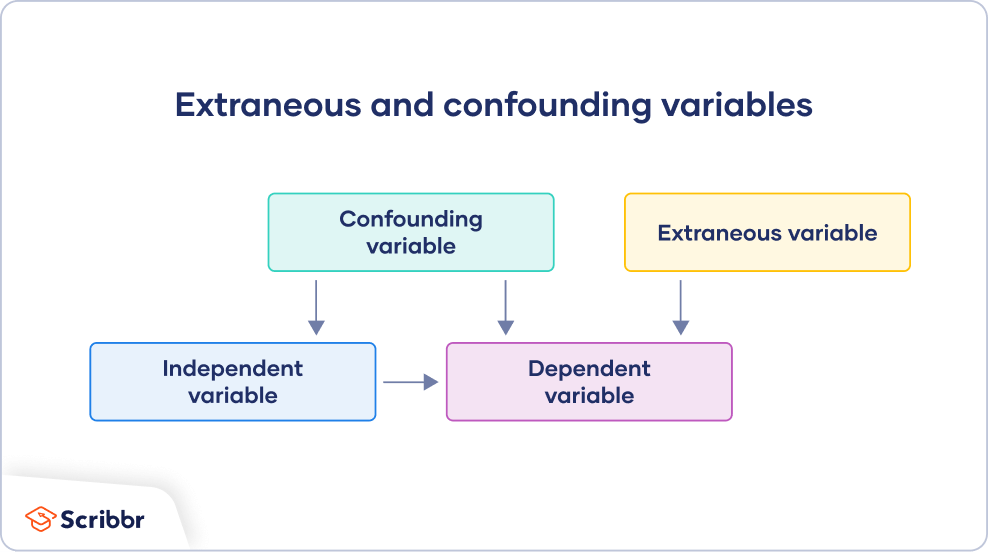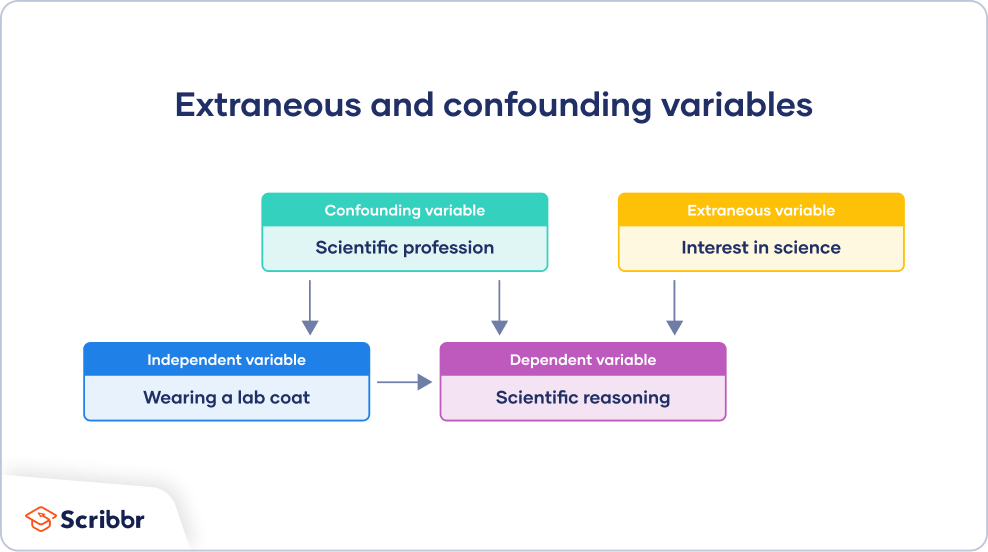Extraneous Variables | Examples, Types, Controls
In an experiment, an extraneous variable is any variable that you’re not investigating that can potentially affect the outcomes of your research study.
If left uncontrolled, extraneous variables can lead to inaccurate conclusions about the relationship between independent and dependent variables.
| Research question | Extraneous variables |
|---|---|
| Is memory capacity related to test performance? |
|
| Does sleep deprivation affect driving ability? |
|
| Does light exposure improve learning ability in mice? |
|
Why do extraneous variables matter?
Extraneous variables can threaten the internal validity of your study by providing alternative explanations for your results.
In an experiment, you manipulate an independent variable to study its effects on a dependent variable.
You recruit students from a university to participate in the study. You manipulate the independent variable by splitting participants into two groups:
- Participants in the experimental group are asked to wear a lab coat during the study.
- Participants in the control group are asked to wear a casual coat during the study.
All participants are given a scientific knowledge quiz, and scores are compared between groups.
When extraneous variables are uncontrolled, it’s hard to determine the exact effects of the independent variable on the dependent variable, because the effects of extraneous variables may mask them.
Uncontrolled extraneous variables can also make it seem as though there is a true effect of the independent variable in an experiment when there’s actually none.
- Participant’s major (e.g., STEM or humanities)
- Participant’s interest in science
- Demographic variables such as gender or educational background
- Time of day of testing
- Experiment environment or setting
If these variables systematically differ between the groups, you can’t be sure whether your results come from your independent variable manipulation or from the extraneous variables.
Controlling extraneous variables is an important aspect of experimental design. When you control an extraneous variable, you turn it into a control variable.
Extraneous vs confounding variables
A confounding variable is a type of extraneous variable that is associated with both the independent and dependent variables.
- An extraneous variable is anything that could influence the dependent variable.
- A confounding variable influences the dependent variable and also correlates with or causally affects the independent variable.
In a conceptual framework diagram, you can draw an arrow from a confounder to the independent variable as well as to the dependent variable. You can draw an arrow from extraneous variables to a dependent variable.

People who work in labs would regularly wear lab coats and may have higher scientific knowledge in general. Therefore, it’s unlikely that your manipulation will increase scientific reasoning abilities for these participants.
Variables that only impact on scientific reasoning are extraneous variables. These include participants’ interests in science and undergraduate majors. While interest in science may affect scientific reasoning ability, it’s not necessarily related to wearing a lab coat.

Types and controls of extraneous variables
Demand characteristics
Demand characteristics are cues that encourage participants to conform to researchers’ behavioural expectations.
Sometimes, participants can infer the intentions behind a research study from the materials or experimental settings, and use these hints to act in ways that are consistent with study hypotheses. These demand characteristics can bias the study outcomes and reduce the external validity, or generalisability, of the results.
They work harder to do well on the quiz by paying more attention to the questions.
You can avoid demand characteristics by making it difficult for participants to guess the aim of your study. Ask participants to perform unrelated filler tasks or fill in plausibly relevant surveys to lead them away from the true nature of the study.
Experimenter effects
Experimenter effects are unintentional actions by researchers that can influence study outcomes.
There are two main types of experimenter effects:
- Experimenters’ interactions with participants can unintentionally affect their behaviours.
- Errors in measurement, observation, analysis, or interpretation may change the study results.
Participants wearing the non-lab coats are not encouraged to perform well on the quiz. Therefore, they don’t work as hard on their responses.
To avoid experimenter effects, you can implement masking (blinding) to hide the condition assignment from participants and experimenters. In a double-blind study, researchers won’t be able to bias participants towards acting in expected ways or selectively interpret results to suit their hypotheses.
Situational variables
Situational variables, such as lighting or temperature, can alter participants’ behaviors in study environments. These factors are sources of random error or random variation in your measurements.
To understand the true relationship between independent and dependent variables, you’ll need to reduce or eliminate the effect of situational factors on your study findings.
To prevent situational variables from influencing study outcomes, it’s best to hold variables constant throughout the study or statistically account for them in your analyses.
Participant variables
A participant variable is any characteristic or aspect of a participant’s background that could affect study results, even though it’s not the focus of an experiment.
Participant variables can include sex, gender identity, age, educational attainment, marital status, religious affiliation, etc.
Since these individual differences between participants may lead to different outcomes, it’s important to measure and analyse these variables.
To control participant variables, you should aim to use random assignment to divide your sample into control and experimental groups. Random assignment makes your groups comparable by evenly distributing participant characteristics between them.
Frequently asked questions about extraneous variables
- What’s the difference between extraneous and confounding variables?
-
An extraneous variable is any variable that you’re not investigating that can potentially affect the dependent variable of your research study.
A confounding variable is a type of extraneous variable that not only affects the dependent variable, but is also related to the independent variable.
- What are the types of extraneous variables?
-
There are 4 main types of extraneous variables:
- Demand characteristics: Environmental cues that encourage participants to conform to researchers’ expectations
- Experimenter effects: Unintentional actions by researchers that influence study outcomes
- Situational variables: Eenvironmental variables that alter participants’ behaviours
- Participant variables: Any characteristic or aspect of a participant’s background that could affect study results
- Why are control variables important?
-
Control variables help you establish a correlational or causal relationship between variables by enhancing internal validity.
If you don’t control relevant extraneous variables, they may influence the outcomes of your study, and you may not be able to demonstrate that your results are really an effect of your independent variable.
- What does ‘controlling for a variable’ mean?
-
‘Controlling for a variable’ means measuring extraneous variables and accounting for them statistically to remove their effects on other variables.
Researchers often model control variable data along with independent and dependent variable data in regression analyses and ANCOVAs. That way, you can isolate the control variable’s effects from the relationship between the variables of interest.
Cite this Scribbr article
If you want to cite this source, you can copy and paste the citation or click the ‘Cite this Scribbr article’ button to automatically add the citation to our free Reference Generator.
Bhandari, P. (2022, December 05). Extraneous Variables | Examples, Types, Controls. Scribbr. Retrieved 22 November 2024, from https://www.scribbr.co.uk/research-methods/extraneous-variable/
